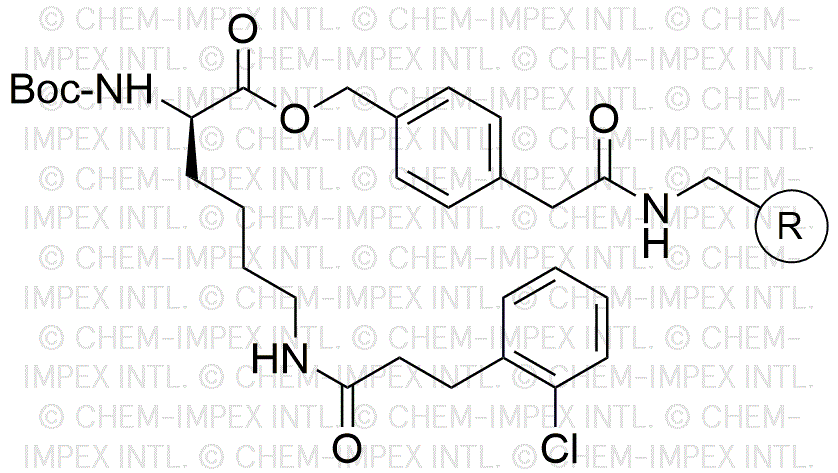Na-Boc-Ne-2-chloro-Z-D-lysine 4-oxymethylphenylacetamidomethyl is widely utilized in research focused on:
- Peptide Synthesis: This compound serves as a key building block in the synthesis of peptides, enabling researchers to create specific sequences for various biological studies.
- Drug Development: It plays a crucial role in the pharmaceutical industry for developing novel therapeutics, particularly in targeting specific proteins or enzymes.
- Bioconjugation: The compound is used in bioconjugation processes, allowing for the attachment of drugs to antibodies or other biomolecules, enhancing drug delivery systems.
- Research on Protein Interactions: It aids in studying protein interactions and modifications, providing insights into cellular mechanisms and disease pathways.
- Custom Chemical Libraries: Researchers utilize it to create diverse chemical libraries for high-throughput screening, facilitating the discovery of new compounds with desired biological activities.
Información general
Propiedades
Seguridad y normativas
Aplicaciones
Na-Boc-Ne-2-chloro-Z-D-lysine 4-oxymethylphenylacetamidomethyl is widely utilized in research focused on:
- Peptide Synthesis: This compound serves as a key building block in the synthesis of peptides, enabling researchers to create specific sequences for various biological studies.
- Drug Development: It plays a crucial role in the pharmaceutical industry for developing novel therapeutics, particularly in targeting specific proteins or enzymes.
- Bioconjugation: The compound is used in bioconjugation processes, allowing for the attachment of drugs to antibodies or other biomolecules, enhancing drug delivery systems.
- Research on Protein Interactions: It aids in studying protein interactions and modifications, providing insights into cellular mechanisms and disease pathways.
- Custom Chemical Libraries: Researchers utilize it to create diverse chemical libraries for high-throughput screening, facilitating the discovery of new compounds with desired biological activities.
Documentos
Hojas de datos de seguridad (HDS)
La SDS proporciona información de seguridad completa sobre la manipulación, el almacenamiento y la eliminación del producto.
Especificación del producto (PS)
La PS proporciona un desglose completo de las propiedades del producto, incluida la composición química, el estado físico, la pureza y los requisitos de almacenamiento. También detalla los rangos de calidad aceptables y las aplicaciones previstas del producto.
Certificados de análisis (COA)
Busque certificados de análisis (COA) ingresando el número de lote del producto. Los números de lote y de partida se pueden encontrar en la etiqueta de un producto después de las palabras "Lote" o "Lote".
Número de catálogo
Número de lote/lote
Certificados de origen (COO)
Este certificado de origen confirma el país en el que se fabricó el producto y también detalla los materiales y componentes utilizados en él y si se deriva de fuentes naturales, sintéticas u otras fuentes específicas. Este certificado puede ser necesario para cumplir con las normativas aduaneras, comerciales y regulatorias.
Número de catálogo
Número de lote/lote
Hojas de datos de seguridad (HDS)
La SDS proporciona información de seguridad completa sobre la manipulación, el almacenamiento y la eliminación del producto.
DownloadEspecificación del producto (PS)
La PS proporciona un desglose completo de las propiedades del producto, incluida la composición química, el estado físico, la pureza y los requisitos de almacenamiento. También detalla los rangos de calidad aceptables y las aplicaciones previstas del producto.
DownloadCertificados de análisis (COA)
Busque certificados de análisis (COA) ingresando el número de lote del producto. Los números de lote y de partida se pueden encontrar en la etiqueta de un producto después de las palabras "Lote" o "Lote".
Número de catálogo
Número de lote/lote
Certificados de origen (COO)
Este certificado de origen confirma el país en el que se fabricó el producto y también detalla los materiales y componentes utilizados en él y si se deriva de fuentes naturales, sintéticas u otras fuentes específicas. Este certificado puede ser necesario para cumplir con las normativas aduaneras, comerciales y regulatorias.


